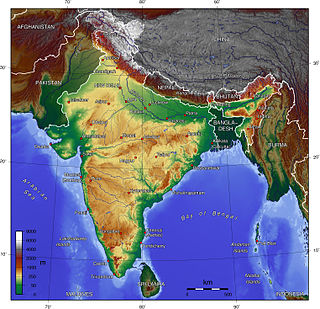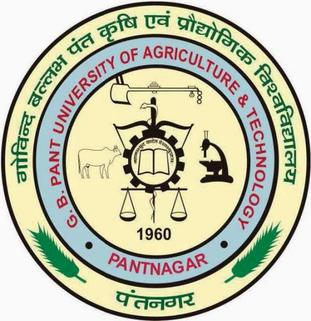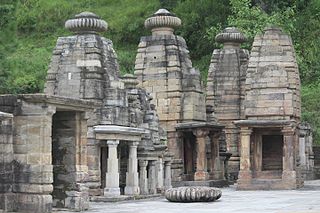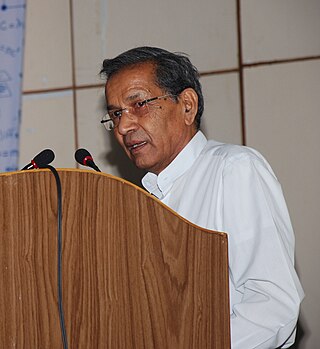
The Himalayas, or Himalaya, is a mountain range in Asia, separating the plains of the Indian subcontinent from the Tibetan Plateau. The range has some of the Earth's highest peaks, including the highest, Mount Everest; more than 100 peaks exceeding elevations of 7,200 m (23,600 ft) above sea level lie in the Himalayas.

Kullu is a district in Himachal Pradesh, India. It borders Shimla district to the south, Mandi and Kangra districts to the west, and the Lahaul and Spiti district to the north and east. The largest valley in this mountainous district is the Kullu Valley. The Kullu valley follows the course of the Beas River, and ranges from an elevation of 833 m above sea level at Aut to 3330 m above sea level at the Atal Tunnel South Portal, below the Rohtang Pass. The town of Kullu, located on the right side of the Beas River, serves as the administrative headquarters of the Kullu district. The Kullu district also incorporates several riverine tributary valleys of the Beas, including those of the Parvati, Sainj, and Tirthan rivers, and thus some regions somewhat distant from the Kullu valley. The economy of the district relies mainly on horticulture, agriculture, tourism, and traditional handicrafts.

Govind Ballabh Pant Institute of Engineering and Technology (GBPIET) is an autonomous institution for higher technical education located in Ghurdauri of Pauri Garhwal district, in the north Indian state of Uttarakhand. College run by the government of Uttarakhand, India. It was created in 1989 and named after the memory of the first Chief Minister of Uttar Pradesh, statesman and Bharat Ratna recipient Pandit Govind Ballabh Pant.

Nainital district is a district in Kumaon division which is a part of Uttarakhand state in India. The headquarters is at Nainital.

Pantnagar is a town and a university campus in Udham Singh Nagar District, Uttarakhand. Nainital, Kashipur, Rudrapur, Kiccha and Haldwani are the major cities surrounding Pantnagar.

Almora is a municipal board and a cantonment town in the state of Uttarakhand, India. It is the administrative headquarters of Almora district. Almora is located on a ridge at the southern edge of the Kumaon Hills of the Himalaya range. The Koshi (Kaushiki) and Suyal (Salmale) rivers flow along the city and snow-capped Himalayas can be seen in the background.

Krishna Chandra Pant was an Indian Member of Parliament for 26 years and was the prime minister's interlocutor on Kashmir. He was a cabinet minister in the Government of India and held several constitutional positions over a period of 37 years. Pant had held the positions of Minister for Defence, Minister of state for Home Affairs, Minister of Steel and Heavy Engineering, Finance, Atomic Energy and Science and Technology. He was the first chairman of the Advisory Board on Energy, chairman of the 10th Finance Commission and the deputy chairman of the Planning Commission of India, the economic planning body of India; his Vision 2020 document was published as India's Development Scenario, Next Decade and Beyond.

The Ministry of Environment, Forest and Climate Change (MoEFCC) is an Indian government ministry. This ministry is headed by Secretary Rank senior most IAS officer. The ministry portfolio is currently held by Bhupender Yadav, Union Minister of Environment, Forest and Climate Change.

The International Centre for Integrated Mountain Development (ICIMOD) is a regional intergovernmental learning and knowledge sharing centre serving the eight regional member countries (RMCs) of the Hindu Kush Himalaya (HKH) region – Afghanistan, Bangladesh, Bhutan, China, India, Myanmar, Nepal, and Pakistan. The HKH region is a vast area, encompassing mountain ranges stretching from the Hindu Kush range in northern Afghanistan to the Arakan range in Myanmar, with the Himalayan range as its spine, and also includes the Tibetan Plateau. ICIMOD promotes and fosters partnerships amongst the RMCs in an effort to secure a better future for the people and environment of the HKH region.

Maulana Azad Medical College (MAMC) is a medical college in New Delhi, India affiliated to University of Delhi and run by the Delhi government. It is named after Indian freedom fighter and first education minister of independent India Maulana Abul Kalam Azad. It was established in 1959 at Bahadur Shah Zafar Marg near Delhi Gate.
Ila Pant is an Indian politician who was a Member of Parliament in 12th Lok Sabha from Nainital constituency of Uttar Pradesh. She was married to former minister K. C. Pant.
The National Environmental Engineering Research Institute (NEERI) in Nagpur was originally established in 1958 as the Central Public Health Engineering Research Institute (CPHERI). It has been described as the "premier and oldest institute in India." It is an institution listed on the Integrated Government Online Directory. It operates under the aegis of the Council of Scientific and Industrial Research (CSIR), based in New Delhi. Indira Gandhi, the Prime Minister of India at the time, renamed the Institute NEERI in 1974.

The Indian Himalayan Region is the section of the Himalayas within the Republic of India, spanning thirteen Indian states and union territories, namely Ladakh, Jammu and Kashmir, Himachal Pradesh, Uttarakhand, Sikkim, West Bengal, Manipur, Meghalaya, Mizoram, Nagaland, Tripura, Assam, and Arunachal Pradesh. The region is responsible for providing water to a large part of the Indian subcontinent and contains various flora and fauna.

G. B. Pant University of Agriculture and Technology, also known as Pantnagar University, is the first agricultural university of India. It was inaugurated by Jawahar Lal Nehru on 17 November 1960 as the "Uttar Pradesh Agricultural University" (UPAU). Later the name was changed to "Govind Ballabh Pant University of Agriculture and Technology" in 1972 in memory of the first Chief Minister of Uttar Pradesh, statesman and Bharat Ratna recipient Pandit Govind Ballabh Pant. The University lies in the campus-town of Pantnagar in Kichha Tehseel and in the district of Udham Singh Nagar, Uttarakhand. The university is regarded as the harbinger of Green Revolution in India.

College of Technology, Pantnagar also known as COT, Pantnagar or COT, is a college located in Pantnagar, in the state of Uttarakhand, India. It was established under the then Uttar Pradesh Agricultural University and now called Govind Ballabh Pant University of Agriculture & Technology. The College of Technology was established in this university in 1962.
Govind Pashu Vihar National Park and Wildlife Sanctuary is a national park in Supin Range, near Uttarkashi town of Uttarkashi district in Uttarakhand, India established initially as a wildlife sanctuary in 1955, and was later converted into a national park. It is named after a prominent Indian freedom fighter and politician Govind Ballabh Pant, who became Home Minister in 1955 and is remembered for his achievement in establishing Hindi as an official language of India.

Katarmal is a remote village located in Kumaon Division, in Almora District, Uttarakhand, India.

Aditya Narayan Purohit is an Indian scientist and professor who has mainly worked on ecophysiology of tree species and physiology of high altitude medicinal plants. He was the Vice-Chancellor of Hemwati Nandan Bahuguna Garhwal University and director of the university's High Altitude Plant Physiology Research Center. He was also the Director of Govind Ballabh Pant Institute of Himalayan Environment and Development from 1990 to 1995.

Sonam Wangchuk is an Indian engineer, innovator and education reformist. He is the founding-director of the Students' Educational and Cultural Movement of Ladakh (SECMOL), which was founded in 1988 by a group of students who had been in his own words, the 'victims' of an alien education system foisted on Ladakh. He is also known for designing the SECMOL campus that runs on solar energy and uses no fossil fuels for cooking, lighting or heating.
















